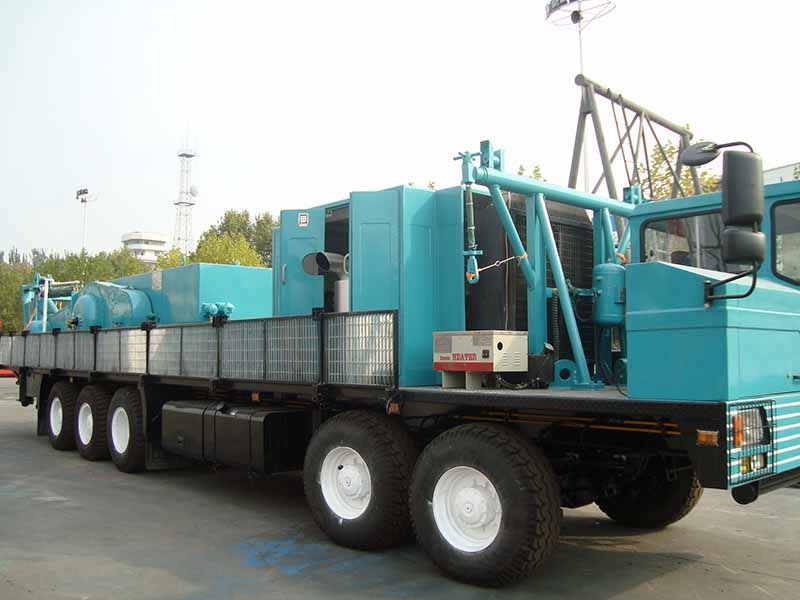What is the control system of a drilling rig?
Oct 29, 2025
The control system of a drilling rig is the core command unit of the entire drilling equipment. It is responsible for integrating, transmitting commands, and regulating the coordinated operation of various components. Without it, the power, transmission, and execution systems of the drilling rig cannot work in an orderly manner, making it an indispensable part. Classified by control methods, it mainly includes mechanical control, pneumatic control, hydraulic control, electric control, and integrated control. Among these, pneumatic control has become the most widely used type due to its advantages of high reliability and adaptability to harsh environments, and its core consists of four major mechanisms: "air supply-command issuance-command transmission-execution".
Ⅰ. Core Classifications of Control Systems
1. Mechanical Control
Mechanical control is the most traditional control method. It directly transmits operating commands through mechanical components such as levers, gears, and wire ropes, featuring the simplest structure and the lowest cost.
Core Principle: Operators manually operate mechanical handles to directly drive transmission components, thereby changing the actions of the execution mechanism (e.g., drawworks braking, rotary table start/stop).
Applicable Scenarios: Simple control of small workover rigs and old drilling rigs, only suitable for operations with low load and low precision requirements.
Limitations: Low control precision (e.g., large drilling pressure adjustment error), labor-intensive operation, inability to achieve remote or automated control, and it has gradually been replaced by other methods.
2. Pneumatic Control
Pneumatic control uses compressed air as the power transmission medium. With the characteristics of "anti-pollution, resistance to high and low temperatures, and fast response", it has become the mainstream control method for onshore and offshore drilling rigs, especially suitable for control needs in harsh environments such as wellheads and mud pumps.
Four Core Mechanisms and Their Functions
Air Supply Mechanism: The power source of the control system, including air compressors, air reservoirs, and dryers, ensuring clean air supply and stable pressure.
Command Issuance Mechanism: The command initiation end of the control system, directly operated by operators (e.g., pneumatic control handles for drawworks hoisting/lowering, buttons). When pressed or toggled, it issues control commands by changing the on/off state of the air circuit or the air pressure.
Command Transmission Mechanism: The command transmission channel of the control system, including air pipelines, solenoid valves (controlling the on/off or commutation of the air circuit to realize electrical signal conversion), and pressure reducing valves (adjusting air pressure to meet the needs of different execution mechanisms). It accurately transmits commands from the command issuance mechanism to the execution mechanism.
Execution Mechanism: The action execution end of the control system, which receives compressed air power and converts it into mechanical actions (e.g., cylinders, air motors, pneumatic control valves for adjusting mud pump displacement), ultimately realizing the start/stop, speed regulation, or commutation of equipment.
Core Advantages
Adaptability to Harsh Environments: Compressed air is non-conductive and non-flammable, immune to dust and oil/gas, less likely to freeze at low temperatures, and has a low failure rate.
Fast Response Speed: The transmission delay of air pressure signals is less than 0.3 seconds, enabling rapid action in emergency working conditions (e.g., shutting down the mud pump in case of well kick) to ensure safety.
Simple Structure and Easy Maintenance: No complex circuits or hydraulic oil pipelines; air pipelines and solenoid valves are easy to replace, resulting in low on-site maintenance costs.
3. Hydraulic Control
Hydraulic control uses hydraulic oil as the transmission medium and drives the execution mechanism through hydraulic pressure, making it suitable for control scenarios with high load and large torque.
Core Applications: Control of heavy-duty components of drilling rigs, such as blowout preventer (BOP) switching, top drive speed regulation, and braking and speed regulation of large drawworks.
Advantages: Large torque transmission and high control precision.
Disadvantages: Hydraulic oil is prone to contamination and requires regular filtration; its viscosity increases at low temperatures, which affects response speed; maintenance costs are higher than those of pneumatic control.
4. Electric Control
Electric control uses electrical signals as the transmission medium and realizes control through motors, frequency converters, and PLC (Programmable Logic Controller). It is the core control method for intelligent drilling rigs.
Core Applications: Precise parameter control (e.g., constant drilling pressure, constant speed), remote monitoring (e.g., onshore remote operation of offshore drilling rigs), and automated processes (e.g., automatic pipe connection).
Advantages: High control precision, enabling data management and automation.
Disadvantages: Relies on stable power supply; anti-short-circuit and anti-interference measures must be taken in humid and dusty environments; initial investment is relatively high.
5. Integrated Control
Integrated control combines the advantages of two or more single control methods and is the mainstream choice for modern medium and large-sized drilling rigs (e.g., "pneumatic + hydraulic + electric control" combination).
Typical Application: Pneumatic control is used for wellhead control (to adapt to oil and gas environments), hydraulic control for heavy-duty components (e.g., BOPs, to provide large thrust), and electric control for overall parameter regulation (to achieve precision and automation). The three are linked through PLC, ensuring safety and reliability while improving control precision and efficiency.
Ⅱ. Core Value of the Control System
Safety Guarantee: Whether it is the emergency shutdown of pneumatic control, the rapid shutdown of BOPs in hydraulic control, or the overload protection of electric control, the control system can quickly cut off risk sources in case of sudden failures (e.g., pipe sticking, well kick) to avoid equipment damage or safety accidents.
Efficiency Improvement: Through precise control (e.g., constant speed regulation in electric control, top drive torque control in hydraulic control), manual operation errors are reduced, and bit wear and wellbore enlargement caused by parameter fluctuations are avoided, thereby improving drilling speed. The automated linkage of integrated control (e.g., coordination between pneumatic wellhead equipment and electric drawworks) can also shorten the time for tripping and pipe connection.
Strong Adaptability: Different control methods can be adapted to different scenarios—pneumatic control for onshore remote oilfields (easy maintenance), integrated control for offshore drilling rigs (balancing safety and precision), and electric control for intelligent drilling rigs (automation needs), ensuring stable operation under various drilling conditions.
Read More





 Language :
Language : English
English Русский
Русский عربي
عربي
 GET A QUOTE
GET A QUOTE



 IPv6 network supported
IPv6 network supported